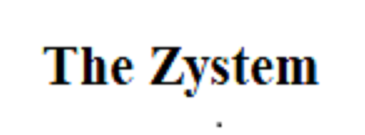One of the things I take pride in is the transparency of my methods and thought processes. Be it projection, valuation, game theory, etc., I’m an open book. Some feel it hurts my game play; maybe they’re right. It doesn’t matter. Once this became my job, be it through one of the companies I work for on a freelance basis or Mastersball subscribers, you get an honest evaluation, unbiased analysis and sincere advice, regardless if it can be used against me in a competitive nature.
Since I began doing this, I’ve publicly detailed how I generate projections and rank players. With the proliferation of new metrics and analysis, mostly Statcast but also elegant research by colleagues, I’ve improved my projections methodology. As such, it’s time to refresh the publicly facing description of the Mastersball projection process, heretofore known as The Zystem.
Truth be told, there will be multiple Zystems: projection, valuation and DFS to name a few. Call it my lame attempt at marketing.
The initial focus will be on The Projection Zystem. The rest of this essay will set the stage for the nitty gritty. Over the next week or so, the nuts and bolts regarding hitting and pitching projections will be shared.
Big picture, the Projection Zystem works as follow:
1. Convert past performance to a neutral environment
MLB players have their numbers normalized using age and park factors. Minor league players and those coming from foreign leagues are converted to an MLE (major league equivalency) which is used as a surrogate for performance.
2. Distill skills to a per plate appearance, inning pitched level
Self-explanatory, more of a bookkeeping process than anything.
3. Apply appropriate regressions
This will be one of the chief cruxes of the ensuing hitting and pitching projections methods. For the purpose of The Zystem, regression will specifically refer to elements of performance out of the player’s control as opposed to a change of skills. For example, a batter can hit a ball at a certain exit velocity and launch angle with a multitude of outcomes. The result is affected by park, weather, atmospheric conditions, men on base, etc. All the hitter controls is the manner they struck the ball.
The mechanism the adjustments are made is via regression levers. All the different levers will be detailed in future pieces, but here’s an idea how they work. In each case where regression applies, there’s an expected result. In statistical terms, it’s the mean. As mentioned, skills do not always manifest in the expected outcome. Regression is adjusting the actual outcome to the expected one. The regression levers set the extent of regression.
It’s a bit presumptuous to consider the methodology behind determining expected results as completely scientifically accurate. Think about Voros McCracken’s DIPS theory. Initially, all pitcher’s regressed to the same BABIP (batting average on balls in play). Then, this was refined to differentiate ground ball from fly ball pitchers. We’re still trying to discern the extent each pitcher controls different batted ball types and the quality of contact.
The point is the original concept of lucky/unlucky centered around how far a pitcher was from the league average BABIP. There wasn’t any accounting for a pitcher’s skill, because it couldn’t be identified. We’re still at the point where the player is driving some of the difference between actual and expected outcomes, but we're not sure to the extent.
Setting the regression lever at 100 brings the projected skill to the expected outcome. Leaving it at zero pegs the skill to the actual level. By default, the regression levels are all set at 50%. This allows subjectivity based on each individual scenario. Admittedly, this removes some objectivity, which should be a tenet of projection methodology, but it allows for personal seasoning.
Another way to look at it is expected and actual skills are a range. It’s plausible for a player to fall in between. Using 50% regression splits the difference. Overriding is a subjective determination where the player will land.
Regression levers are utilized for the following:
Hitters
- Hits
- Homers
- RBI
- Runs
- Stolen base opportunities
Pitchers
- Hits
- Homers
- Strikeouts
- Walks
- ERA
4. Determine projected skill levels using weighted average of three years’ worth of neutralized and regressed past performances
Marcels uses a three-year weighted average of 5:4:3 with 5 most recent. Based on some back-testing, The Zystem uses 11:7:4. With the tests showing the 2019 baseball was subject to reduce drag, serious consideration was given to changing so the 2019 data was weighted more than 50%. However, it was decided the 2017 ball was close enough to last year’s it served as the adjustor, with 2018 being the hedge in case the ball is changed.
5. Apply appropriate park indices
Self-explanatory, noting the following stats are park-adjusted:
- Hits
- Doubles
- Triples
- Homers
- Strikeouts
- Walks
6. Multiply by projected playing time
Self-explanatory, with the note playing time projections are even more important than skills. This is often overlooked and is usually the difference between projection sources. As such, projecting playing time deserves its own treatment thus will be included in the forthcoming essays.
There you have, an overview of the Projection Zystem. Please follow social media (@Mastersball, @toddzola on Twitter, Mastersball on Facebook) for notification when follow-up pieces are posted.
Todd Zola is the Primary Owner and Lead Content Provider for Mastersball. He’s the defending Great Fantasy Baseball Invitational champion, besting 314 of the industry’s finest. Todd is a former Tout Wars and LABR champion along with a multi-time NFBC league winner.

